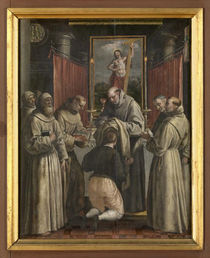The Catholic Defender: Saint Magdalene of Canossa
- Donald Hartley

- Apr 9
- 3 min read
Updated: Apr 12
Deepertruth with special permission and aid with Franiciscan Media, a great team for the Lord

Magdalena di Canossa (1 March 1774 – 10 April 1835) was an Italian professed religious and foundress of the two Canossian congregations.
Wealth and privilege did nothing to prevent today’s saint from following her calling to serve Christ in the poor. Nor did the protests of her relatives, concerned that such work was beneath her.
Born in northern Italy in 1774, Magdalene knew her mind—and spoke it. At age 15 she announced she wished to become a nun. After trying out her vocation with the cloistered Carmelites, she realized her desire was to serve the needy without restriction. For years she worked among the poor and sick in hospitals and in their homes, and also among delinquent and abandoned girls.
At 17, she believed she was called to the life of the cloister and attempted to join the Carmelites twice, but the Spirit of God urged her interiorly to give herself to the service of the neediest persons whom the convent grills prevented her from reaching out to.

Magdalene of Canossa started her charitable works at the age of 34, after a long struggle and search for God’s will for her.
Under the Canossian education, we learn from our Foundress, St. Magdalene of Canossa on how to love selflessly and offer our humble service to others. “Those who love are never tired, since love knows no burden”. With Love, we are driven to serve each other with humility and show concern for the needy.
In the midst of her tireless activities and heavy family responsibilities, Magdalene found the time to intensify her prayer, the daily contemplation of the Love of Christ on the Cross and of the Mother of Sorrows.
In her mid-20s, Magdalene began offering lodging to poor girls in her own home. In time she opened a school, which offered practical training and religious instruction. As other women joined her in the work, the new Congregation of the Canossian Daughters of Charity—or Canossian Sisters—emerged. Over time, houses were opened throughout Italy.

Inflamed by the same fire of God’s love, she opened herself to the cry of the poor, hungering for bread, instruction and God.
In 1808, having overcome the final resistances from her family, she left the Canossa Palace to initiate, in Verona, what she interiorly felt was God’s will: to serve Christ in the poor.
Using her large inheritance, Magdalene founded the Canossian Daughters of Charity, who ministered to the people living in the slums of Verona. Someone donated an old convent to Magdalene, and then they added convents in Venice and Milan. Pope Leo XII gave his blessing to the new congregation in 1823.
Members of the new religious congregation focused on the educational and spiritual needs of women. Magdalene also founded a smaller congregation for priests and brothers. Both groups continue to this day.
Magdalene died in 1835. Pope John Paul II canonized her in 1988.
Let us pray to Saint Magdalene for the many young women who are caught up in the sex trafficking epidemic of our day.

Today, the Institute of the Daughters of Charity are present in all five continents. The Sisters number about 2,300, constituting 18 provinces and work on spreading of the Kingdom of God.
It is Magdalene’s apostolic invitation to all the lay people, who, in syntonic with her charism rooted in the Spirit of Jesus Crucified, wish to collaborate in their state in life and workplace to spread the Kingdom of God.
Today, the Institute of the Daughters of Charity are present in all five continents. The Sisters number about 2,300, constituting 18 provinces and work on spreading of the Kingdom of God.
On December 7, 1941, she was proclaimed Blessed by Pope Pius XII. She was declared a Saint by Pope John Paul II on October 2, 1988.





















Comments